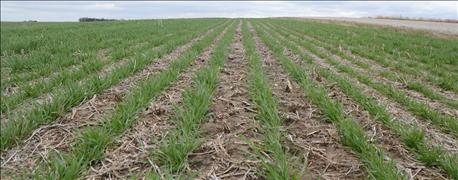
Nebraska's winter wheat crop had a rough go round last year. Following severe winterkill and disease pressure from stripe rust and fusarium head blight, Nebraska saw some of the lowest total harvested bushels it's seen in years. Last year, Nebraska wheat growers harvested just under 46 million bushels – a 25 million-bushel drop from 2014's 71 million bushels, according to USDA National Agricultural Statistics Service data.
"The wheat was just hammered by so many factors that the yield was very low," says Stephen Wegulo, University of Nebraska professor and Extension plant pathologist.

OFF TO A GOOD START: Most of the winter wheat crop was planted on time, and while there have been concerns of winterkill with wheat breaking dormancy earlier, Wegulo says that isn't likely unless temperatures drop down below freezing.
Winter wheat off to a good start
This year, the situation is looking more promising. Most of the crop was planted on time, and while there have been concerns of winter injury or winterkill with wheat breaking dormancy earlier and premature spring growth, especially after recent freezing temperatures, Wegulo notes after a good start to the 2015-2016 growing season, much of the crop is in better shape than it was last year.
"The difference between this year and 2015 is that in the fall of last year, when the 2016 winter wheat crop was planted, we had sufficient moisture, so the germination was good compared to the fall of 2014 when it was very dry," he says. "Because of the lack of moisture in the fall of 2014, growers didn't get the right planting depth, germination was quite poor and wheat was very vulnerable to winterkill. Then in the winter of 2014 to 2015 we had very little snow cover. That exposed the wheat to harsh temperatures."
Rust showing up in southern states
What may become a problem, Wegulo says, is stripe rust. Stripe rust, identifiable by yellow streaks or stripes that run parallel to the leaf, is favored by wet conditions and cooler temperatures – optimal conditions for stripe rust are around 50 to 59 degrees Fahrenheit.

Stripe rust (Photo credit: Stephen Wegulo)

Leaf rust
~~~PAGE_BREAK_HERE~~~
With this winter's abnormally warm temperatures, stripe rust has been active earlier than usual in southern states like Oklahoma, Texas, Arkansas, and Louisiana – there have even been reports of leaf rust and stem rust, which are favored by temperatures in the 60's and 70's. Recently, stripe rust and leaf rust have been confirmed in Kansas as well.
"Usually we start seeing stripe rust in Oklahoma in April, but they have been seeing it since early March," Wegulo says. "Given what we see in the south, I think the risk is there, and growers should be prepared for stripe rust. We may see stripe rust starting in late April or mid-April."
Start scouting for diseases now
Compared to other early season diseases, like powdery mildew, leaf spot, tan spot, and septoria, stripe rust spreads much more quickly and brings a significant yield hit.
That's why it's a good idea to start scouting now for stripe rust and other early-season diseases. If stripe rust is a concern early on, a fungicide application at elongation may be warranted.
"Depending on whether we have significant stripe rust pressure, which I would expect if we get sufficient rainfall, then an early application at the time they put on herbicide may be necessary, but the more important timing will be to protect the flag leaf which will come later in May," Wegulo says. "The spring season is coming earlier, so the flag leaf may come earlier than normal. Where the risk is high early in the season, some growers may need to apply during elongation."
By scouting, identifying stripe rust early on and making a fungicide application at elongation and again at flag leaf, some growers last year realized a yield benefit of at least 20 bushels over those who only applied at flag leaf, Wegulo adds.
"That's why growers need to scout. If they see stripe rust in the field I would suggest they make an early application to stop it," he says. "Given the warm temperatures we are having, I think they should start scouting as soon as possible to have a good idea what's going on in their fields."
For additional information, contact Wegulo at [email protected].
About the Author(s)
You May Also Like






